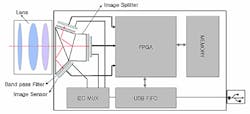Modified CCD camera captures multispectral images
Researchers at Seoul National University (Seoul, Korea) have taken a conventional camera with three CCDs and modified it to detect scabs and bruises on the surface of Fuji apples.
Their modified camera comprises a lens, an image splitter and three 740, 820 and 1000nm optical band-pass filters that the researchers placed in front of the three CCDs in the camera to enable it to capture multispectral images of the apples.
Once captured, the images from each of the CCDs are processed in parallel by an FPGA onboard the camera. Image normalization was performed to compensate for the brightness difference between the images from each of the CCDs due to the different spectral response of each of the optical filters and image sensors.
To highlight the location of scabs on the apples, application software written in Microsoft's Visual C++ was used to subtract the images from the two CCD imagers equipped with the 740 and 1000nm filters, while the detection of the bruises was achieved by subtracting the images from the CCD imagers with the 820 and 1000nm filters.
Researcher Hoyoung Lee and his colleagues detailed the design of the new camera and highlighted its image processing capabilities in a recent article entitled "Development of Filter Exchangeable 3CCD Camera for Multispectral Imaging Acquisition." It can be found here.
Recent articles on multispectral imaging from Vision Systems Design.
1. Spectral vision systems support the food industry
A project known as Optifood-Spectral is to explore how spectral image-analysis techniques can be applied to serve the needs of integrators that develop automated analysis systems.
2. Spectral imaging sorts 'sugar-end' defects
EVK has helped to develop a system with machine builder Insort to inspect the quality of potatoes, specifically determining whether or not they had been afflicted by what are known as "sugar-end defects."
3. Multispectral scanning reveals hidden detail in old documents
A multispectral scanner the size of a desktop scanner has been developed at the University of Oxford's (Oxford, UK; www.ox.ac.uk) Faculty of Classics. It is now being commercialized by a new company, Oxford Multi Spectral, spun out by the University's technology transfer company Isis Innovation.
-- Dave Wilson, Senior Editor, Vision Systems Design
